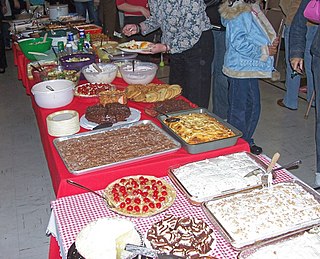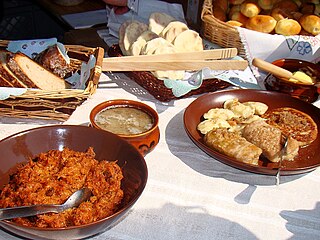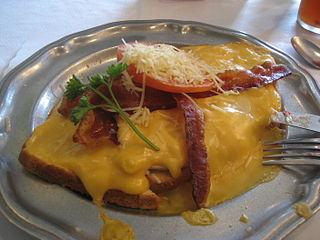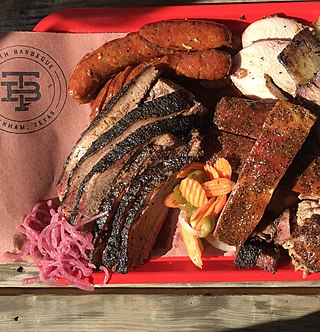
American cuisine consists of the cooking style and traditional dishes prepared in the United States. It has been significantly influenced by Europeans, Indigenous Americans, Africans, Latin Americans, Asians, Pacific Islanders, and many other cultures and traditions. Principal influences on American cuisine are European, Native American, soul food, regional heritages including Cajun, Louisiana Creole, Pennsylvania Dutch, Mormon foodways, Texan, Tex-Mex, New Mexican, and Tlingit, and the cuisines of immigrant groups such as Chinese American, Greek American, Italian American, Arab American, Jewish American, and Mexican American. The large size of America and its long history of immigration have created an especially diverse cuisine that varies by region.

The cuisine of the American Midwest draws its culinary roots most significantly from the cuisines of Central, Northern and Eastern Europe, and Indigenous cuisine of the Americas, and is influenced by regionally and locally grown foodstuffs and cultural diversity.

New England cuisine is an American cuisine which originated in the New England region of the United States, and traces its roots to traditional English cuisine and Native American cuisine of the Abenaki, Narragansett, Niantic, Wabanaki, Wampanoag, and other native peoples. It also includes influences from Irish, French-Canadian, Italian, and Portuguese cuisine, among others. It is characterized by extensive use of potatoes, beans, dairy products and seafood, resulting from its historical reliance on its seaports and fishing industry. Corn, the major crop historically grown by Native American tribes in New England, continues to be grown in all New England states, primarily as sweet corn although flint corn is grown as well. It is traditionally used in hasty puddings, cornbreads and corn chowders.

The cuisine of the Southern United States encompasses diverse food traditions of several subregions, including cuisine of Southeastern Native American tribes, Tidewater, Appalachian, Ozarks, Lowcountry, Cajun, Creole, African American cuisine and Floribbean, Spanish, French, British, and German cuisine. In recent history, elements of Southern cuisine have spread to other parts of the United States, influencing other types of American cuisine.

Cornbread is a quick bread made with cornmeal, associated with the cuisine of the Southern United States, with origins in Native American cuisine. It is an example of batter bread. Dumplings and pancakes made with finely ground cornmeal are staple foods of the Hopi people in Arizona. The Hidatsa people of the Upper Midwest call baked cornbread naktsi, while the Choctaw people of the Southeast call it bvnaha. The Cherokee and Seneca tribes enrich the basic batter, adding chestnuts, sunflower seeds, apples, or berries, and sometimes combine it with beans or potatoes. Modern versions of cornbread are usually leavened by baking powder.

Polish cuisine is a style of food preparation originating in and widely popular in Poland. Due to Poland's history, Polish cuisine has evolved over the centuries to be very eclectic, and shares many similarities with other national cuisines. Polish cooking in other cultures is often referred to as à la polonaise.

Trinidad and Tobago has a unique history and its food is influenced by Indian-South Asian, West African, Creole, European, American, Chinese, Amerindian, and Latin American culinary styles. Trinidadian and Tobagonian food is dominated by a wide selection of dishes, most notably, doubles, roti, pelau, callaloo and curried crab and dumplings. Trinidad and Tobago is also known for its prepared provisions, such as dasheen, sweet potato, eddoes, cassava, yam, soups and stews, also known as blue food across the country. Corresponding to the Blue Food Day event held annually in Trinidad and Tobago.

A fritter is a portion of meat, seafood, fruit, vegetables, or other ingredients which have been battered or breaded, or just a portion of dough without further ingredients, that is deep-fried. Fritters are prepared in both sweet and savory varieties.

Pennsylvania Dutch cuisine is the typical and traditional fare of the Pennsylvania Dutch.
Soup beans is a term common in the Southern United States, particularly the regions around the Appalachian Mountains. Soup beans are usually served with cornbread, greens, and potatoes and may be topped with raw chopped onions or ramps. Soup beans are considered a main course, but also serve as a side dish. In rural areas, where food was scarce during the winter, these dried beans were a staple food.

The cuisine of Kentucky mostly resembles and is a part of traditional Southern cuisine. Some common dinner dishes are fried catfish and hushpuppies, fried chicken and country fried steak. These are usually served with vegetables such as green beans, greens, pinto beans slow-cooked with pork as seasoning and served with cornbread. Other popular items include fried green tomatoes, cheese grits, corn pudding, fried okra, and chicken and dumplings, which can be found across the commonwealth.

Belizean cuisine is an amalgamation of all ethnicities in the nation of Belize and their respectively wide variety of foods. Breakfast often consists of sides of bread, flour tortillas, or fry jacks that are often homemade and eaten with various cheeses. All are often accompanied with refried beans, cheeses, and various forms of eggs, etc. Inclusive is also cereal along with milk, coffee, or tea.

Texan cuisine is the food associated with the Southern U.S. state of Texas, including its native Southwestern cuisine–influenced Tex-Mex foods. Texas is a large state, and its cuisine has been influenced by a wide range of cultures, including Tejano/Mexican, Native American, Creole/Cajun, African-American, German, Czech, Southern and other European American groups. The cuisine of neighboring states also influences Texan cuisine, such as New Mexican cuisine and Louisiana Creole cuisine. This can be seen in the widespread usage of New Mexico chiles, Cayenne peppers, and Tabasco sauce in Texan cooking.
Ronni Lundy, is an American author and editor, whose work focuses on traditional Southern American foods, Appalachian foods, and music.

Mormon foodways encompass the traditional food and drink surrounding the religious and social practices of members of the Church of Jesus Christ of Latter-day Saints and other churches in the Latter Day Saint movement, colloquially referred to as Mormons. The Word of Wisdom prohibits Mormons from consuming alcohol, coffee, and tea. These restrictions began to be observed more closely in the 20th century. Traditionally, members are encouraged to fast two meals during the first Sunday of each month.

















